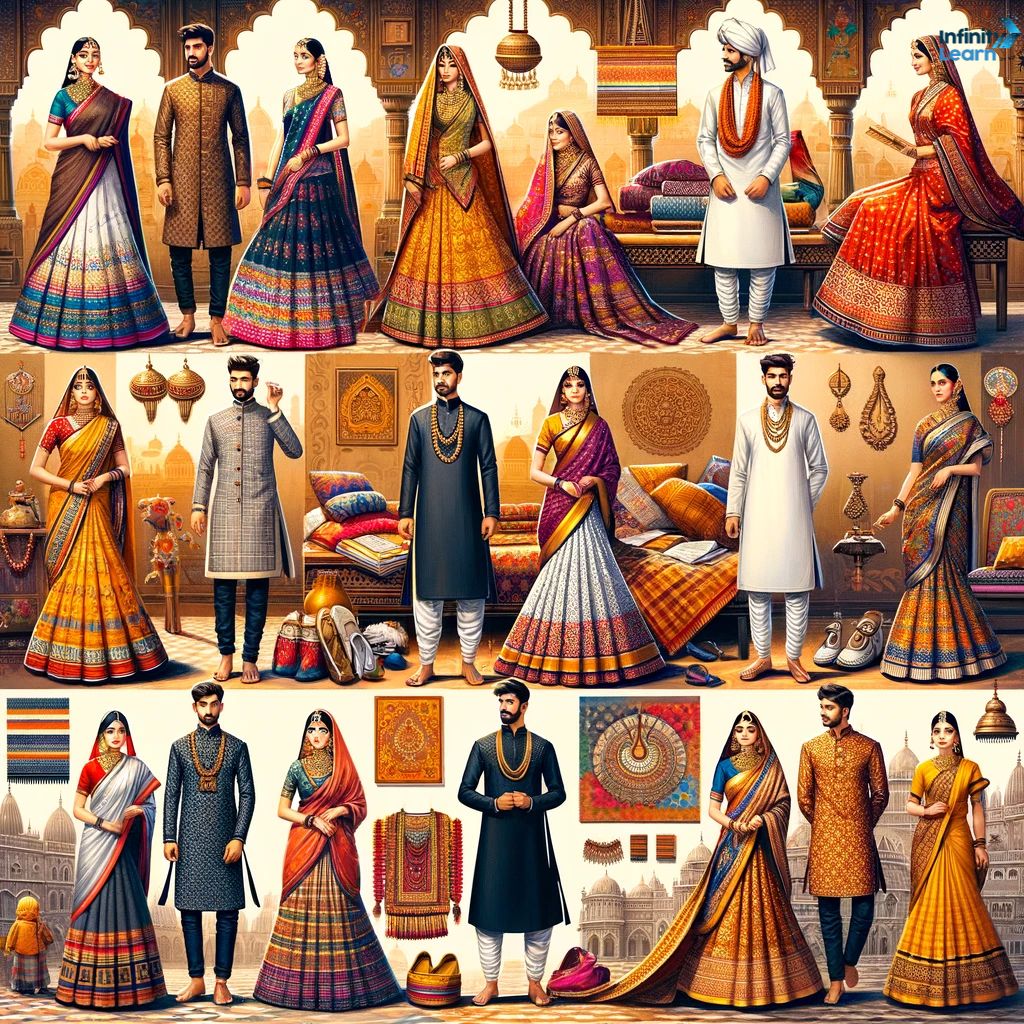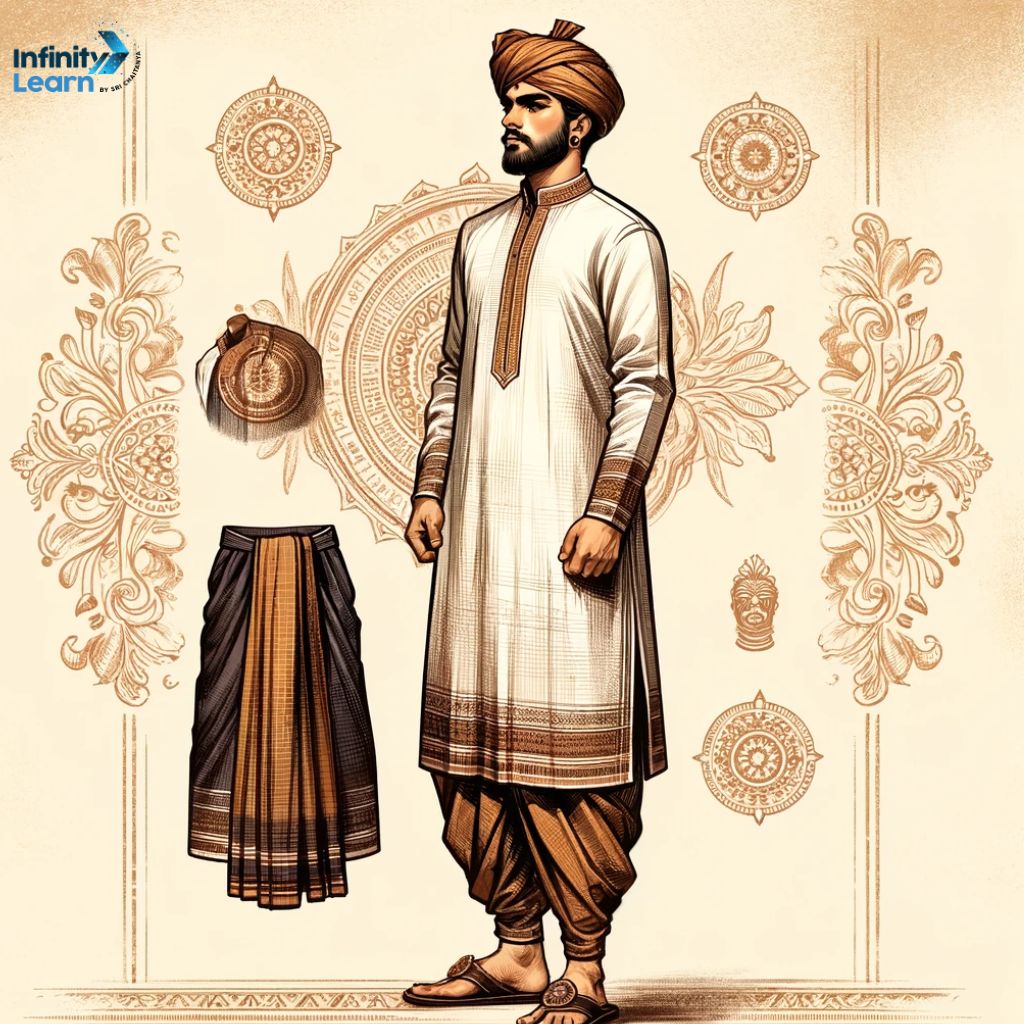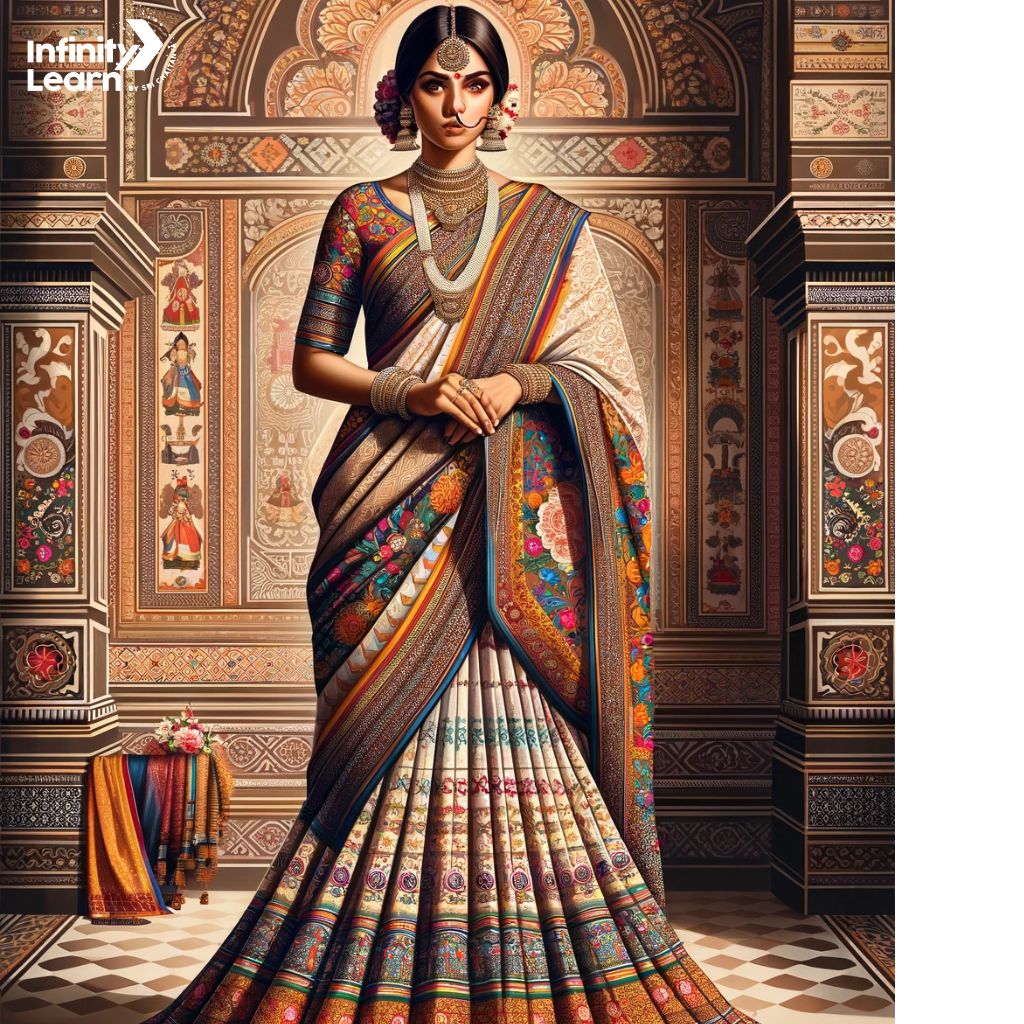Table of Contents
In Maharashtra, a western state in India, people have their own special clothes. Women often wear a saree called ‘Nauvari’, which is very long, about nine yards. It’s a special kind of saree showing the Maharashtra traditional dress culture. Men usually wear a dhoti, a kurta, and a pheta. The dhoti is a long piece of cloth for the lower body, often in colors like saffron, cream, or white. The kurta is a shirt worn with the dhoti. The pheta is a kind of headgear that Marathi men wear. These clothes are very important in Maharashtra. They show the state’s history and the way people live and work there.
History of Maharashtra Traditional Dress
The history of Maharashtra traditional dress is deeply rooted in the state’s rich cultural heritage and diverse social traditions.
The traditional dress for women in Maharashtra is known as the Nauvari saree, a special name that means ‘nine yards’, showing its length. This saree is a symbol of the rich culture in Maharashtra. Another important saree is the Paithani saree, famous for its wide pallu, ranging from 18 to 25 inches. This saree shows the skill in textile design in the region. In Maharashtra, Brahmin ladies wear their sarees uniquely, with pleats at the back, tucked in at the waist, and the decorated part draped over the shoulder.
These dresses are more than just clothes; they are a part of Maharashtra’s cultural identity. They show the history and social life of the state. Maharashtra traditional dress for women is often worn on special days and festivals, letting women celebrate their rich heritage. Over time, these dresses have changed to match the region’s social and economic shifts.
| Rajasthani Traditional Dress | Traditional Dress of Gujarat |
| Kerala Traditional Dress | Odisha Traditional Dress |
What is The Traditional Dress of Maharashtra
The Maharashtra traditional dress varies and shows the state’s rich culture. For men, the usual outfit is a dhoti, kurta, and pheta. The dhoti is a long cloth worn around the waist, often in colors like saffron, cream, or white. A kurta is a shirt worn over the dhoti. The pheta is a headgear that Marathi men wear.
For women, a common traditional dress is the Nauvari saree, which is nine yards long. This saree is special because it reflects the area’s tradition and doesn’t need a petticoat. Another popular saree for women in Maharashtra is the Paithani saree, known for its long “pallu” (the part of the saree that drapes over the shoulder). This saree comes from skilled textile work.
Brahmin women in Maharashtra have a unique way of wearing their sarees. They tuck the pleats at the back and let the decorated end hang over the shoulder.
These dresses are a big part of Maharashtra’s cultural identity and show the history and social life of the area.
Maharashtra Traditional Dress Images

Traditional Dress of Maharashtra Men-Women
The Maharashtra traditional dress is an important part of the state’s culture. For men in Maharashtra, the usual dress is a dhoti, kurta, and pheta. Women often wear a saree called ‘Nauvari‘ or a Paithani saree. The Nauvari saree is special because it’s worn in a way that doesn’t need a petticoat. The Paithani saree has a long end piece, called pallu, and is known for its unique textile design. These dresses show the variety in Maharashtra’s culture. Keeping these clothes as part of life is key because they represent Maharashtra’s rich culture.
In the next parts, we will talk more about the dresses for men and women in Maharashtra.
Maharashtra Traditional Dress for Men
In Maharashtra, the traditional dress for men reflects the state’s heritage. This attire includes a dhoti, a long piece of cloth worn around the waist and legs, often in saffron, cream, or white. It’s secured with five tucks on each side. Men wear a kurta on top, a loose, thin shirt, usually white and made of cotton, which helps in staying cool. A key element is the pheta, a turban that adds elegance to the outfit. Sometimes, a bandi, a sleeveless jacket, is added for a more formal appearance. The typical footwear is durable leather sandals. This dress is often worn during special occasions and festivals, showcasing the cultural identity of Maharashtra’s men.
Maharashtra Traditional Dress for Women
In Maharashtra, the traditional dress for women is a unique representation of the state’s culture. Women often wear a saree, a long fabric draped around the body. The saree is typically vibrant, adorned with intricate designs, and comes in various colors. Accompanying the saree is a blouse, a short top that matches the saree’s style. Women also accessorize with jewelry like necklaces and bangles, adding to the elegance of the outfit. This dress is chosen for special events and festivals, showing the rich cultural identity of Maharashtra’s women. It’s known for its beauty and is a key part of Maharashtra’s traditional dress.
| Culture of Rajasthan | Culture of Kerala |
| Culture of Manipur | Culture of Assam |
| Culture of Andaman and Nicobar Islands |
Maharashtra Traditional Dress Name
Maharashtra, a state in the western part of India, is known for its strong cultural background. This is especially seen in the clothes people wear. For women in Maharashtra, the traditional dress is an important part of their identity and heritage. These outfits vary in their designs, colors, and materials, showing off Maharashtra’s skilled craftsmanship. They are often worn for special events and festivals. Each dress has its own unique name, representing Maharashtra’s rich culture and art. This article will talk about the different names and details of Maharashtra traditional dress for women.
Maharashtra Traditional Dress Name Male
- Dhoti
- Kurta
- Pheta (Turban)
- Bandi (Waistcoat)
- Footwear
Dhoti
- The Dhoti, a rectangular piece of unstitched cloth, is a traditional lower garment worn by men in Maharashtra. It’s usually white or cream in color and is wrapped around the waist, then folded in a specific manner to resemble trousers.
- Symbolizing simplicity and cultural heritage, the dhoti is a staple in Maharashtrian traditional attire and is often worn during religious ceremonies and important cultural events.
Kurta
- Accompanying the dhoti is the Kurta, a long shirt that typically reaches the knees. It’s a loose-fitting upper garment, usually made from cotton or silk, featuring long sleeves and a buttoned placket.
- The kurta represents modesty and comfort, and its simplicity complements the dhoti. It’s a popular choice for everyday wear as well as for special occasions.
Pheta (Turban)
- The Pheta, or turban, is a headgear made of a long cloth, usually cotton or silk, wound around the head in a particular style. It comes in various colors, with saffron being a popular choice.
- The Pheta is a symbol of honor and respect. It’s traditionally worn during weddings, religious ceremonies, and cultural festivals, and is a mark of pride and prestige.
Bandi (Waistcoat)
- The Bandi, a type of waistcoat, is often worn over the Kurta. This sleeveless garment can be plain or embroidered, adding an element of formality to the attire.
- The Bandi adds an aesthetic appeal to the traditional attire and is a popular addition during weddings and festive occasions. It represents a blend of traditional attire with a touch of modern style.
Footwear
- Traditional Maharashtrian footwear typically includes Kolhapuri Sandals or simple shoes, often made from leather. These are designed for comfort and durability, suitable for the local climate and terrain.
- Footwear in traditional dress is chosen for practicality and comfort, complementing the simplicity and elegance of the entire attire. It underscores the importance of functionality in traditional Maharashtrian culture.

Maharashtra Traditional Dress Female Name
- Sarees
- Choli
- Himroo and the Mashru
- Angarkha
- Mundu
- Ghagra
Sarees
-
- Nauvari Sari: A unique style of saree, the Nauvari is traditionally worn in a dhoti style. Its name, ‘Nauvari’, literally means ‘nine-yards’, indicating its length. This style of draping is distinctive to Maharashtra and allows greater freedom of movement, resembling a trouser-like appearance.
- Peshwai Sari: Originating from the Peshwa period, this saree is known for its rich and royal look. It is often made of silk and features intricate patterns and borders, reflecting the grandeur of the Maratha regime.
-
- Paithani Saree: Named after the Paithan town in Aurangabad, Maharashtra, Paithani sarees are known for their handwoven silk and exquisite gold and silver zari work. These sarees are distinguished by their vibrant colors and intricate designs, often featuring motifs of birds and flowers.
- Karvat Kati Saree: This saree is unique for its border design, known as ‘Karvat Kati’, which means ‘scissor-cut’. The intricate designs are often inspired by local flora and fauna and are known for their precision and elegance.
- Ganga-Jamuna Saree: Named after the two holy rivers of India, the Ganga and the Jamuna, these sarees are characterized by their dual-colored borders, representing the confluence of these rivers.
Choli
A form-fitting blouse worn with sarees, the Choli is an essential part of the traditional Maharashtrian attire. It is often designed to match the saree, with intricate embroidery or patterns.
Himroo and the Mashru
Himroo is a rich fabric originally from Aurangabad, known for its luxurious texture, often used in shawls and sarees. Mashru, on the other hand, is a silk and cotton fabric blend, known for its shiny appearance and comfort.
Angarkha
A traditional upper garment, the Angarkha is a form-fitting top that wraps around the body. It’s known for its elegance and is often made from luxurious fabrics with detailed embroidery.
Mundu
This is a garment worn below the waist, similar to a lungi or dhoti, and is a part of traditional attire for men in Maharashtra, often paired with a kurta or shirt.
Ghagra
A long, flowing skirt often worn with a choli and dupatta, the Ghagra is part of traditional festive and bridal attire in Maharashtra, known for its vibrant colors and intricate designs.

Maharashtra Traditional Dress Information
- The traditional dress for men in Maharashtra consists of a dhoti, kurta, and pheta. The dhoti is a rectangular piece of cloth worn as a lower garment, usually in saffron, cream, or white color. The kurta is worn above the dhoti, and the pheta is a headdress worn by Marathi men.
- The traditional attire of Maharashtra for women is the saree named ‘Nauvari’, which means ‘nine yards’, signifying the length of the saree. It is a unique saree that embodies the rich culture and heritage of the region. The Paithani saree is another traditional dress for women in Maharashtra, which is invested with an 18-inch to 25-inch pallu and owes its origin to adept textile-designing.
- The traditional dresses of Maharashtra are diverse and reflect the state’s cultural diversity. The names, styles, and accessories of Maharashtra traditional dress for men and women are diverse and reflect the state’s cultural diversity.
- The traditional dresses of Maharashtra are an integral part of the state’s cultural identity and heritage, reflecting the historical, social, and economic conditions of the region.
- The traditional dresses of Maharashtra are often worn during special occasions and festivals, allowing the people of Maharashtra to embrace their rich cultural heritage.
FAQs on Maharashtra Traditional Dress
What color do Maharashtrian brides wear?
Maharashtrian brides typically wear a red or maroon saree, which symbolizes happiness and prosperity.
Which saree do Maharashtrian wear?
Maharashtrian women wear the Nauvari saree, which is a nine-yard saree that is unique to the region.
What is the dress of Maharashtrian couple?
Maharashtrian couples can wear traditional dresses like the dhoti and kurta for men, and the Nauvari saree for women.
What is the most popular dress of Maharashtra?
The most popular dress of Maharashtra is the Nauvari saree for women, which is a symbol of the region's rich culture.
How to dress up like Maharashtra?
To dress up like Maharashtra, men can wear the dhoti, kurta, and pheta, while women can wear the Nauvari saree or the Paithani saree. Accessories like gajra (flower garlands) and traditional jewelry can also enhance the look.








